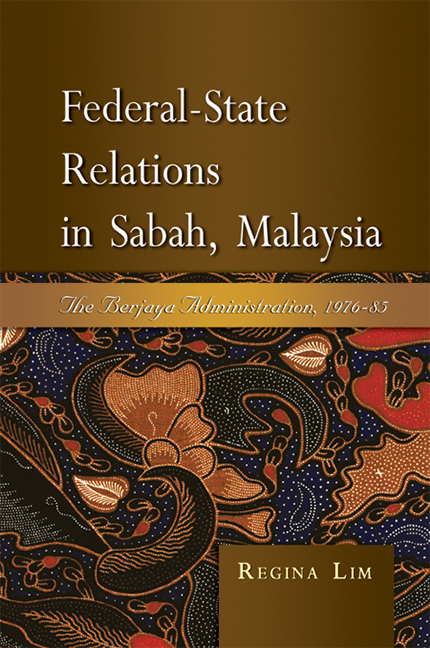Book contents
- Frontmatter
- Contents
- List of Tables and Figures
- Acknowledgements
- Abbreviations and Glossary of Terms
- 1 Introduction
- 2 Sabah Before Malaysia
- 3 Contesting the Rules of the Game, 1963–76
- 4 BERJAYA and Federal-state Relations
- 5 Development and Patronage
- 6 The Contest for Islamic Leadership and Multiracial Votes
- 7 Epilogue and Conclusion
- References
- Index
- About the Author
4 - BERJAYA and Federal-state Relations
Published online by Cambridge University Press: 21 October 2015
- Frontmatter
- Contents
- List of Tables and Figures
- Acknowledgements
- Abbreviations and Glossary of Terms
- 1 Introduction
- 2 Sabah Before Malaysia
- 3 Contesting the Rules of the Game, 1963–76
- 4 BERJAYA and Federal-state Relations
- 5 Development and Patronage
- 6 The Contest for Islamic Leadership and Multiracial Votes
- 7 Epilogue and Conclusion
- References
- Index
- About the Author
Summary
INTRODUCTION
This chapter looks at how the ‘multiracial’ politics of the BERJAYA Government in Sabah took shape within the ambit of the Federal Government's policies, particularly in the ‘federalization’ of strategic Sabah Government affairs by Kuala Lumpur. The BERJAYA party never really defined what it meant by ‘multiracialism’. However, it was a term that was agreed on by both the Federal Government and BERJAYA to politically undermine the pro-Muslim appeal of the USNO party, and as a way of appealing to the non-Muslim electorate in Sabah. As far as the political organization of the BERJAYA party was concerned, a ‘multiracial’ party suggested a relatively broader ethnic representation within the party and the State Cabinet. The ethnic distribution of BERJAYA's candidates for the 1976 Sabah State election was 24 Muslim bumiputera, 14 non-Muslim bumiputera and 10 Chinese candidates, as opposed to the majority of Muslim candidates in USNO. Maintaining the ethnic balance within the State Government was important in projecting a ‘multiracial’ representation. However, BERJAYA's pledge on ‘multiracialism’ was complicated by the process of ‘federalization’, here understood as the transfer of certain State jurisdictions on Sabah affairs to Federal Administration. The federalization of a number of State departments and the transfer of Labuan to Federal control in 1984, for instance, did not necessarily strengthen the State Administration in Sabah, but it was an enabling process for the Federal Government to rationalize Federal-State relations, and subsequently the State Government as well.
After the 1969 national emergency, politics at the Federal level was affected by the UMNO party crisis. This crisis was situated in the disagreements between Tunku Abdul Rahman and Razak over the root cause and the subsequent analysis of the 1969 ethnic incident (Khoo 1992).
- Type
- Chapter
- Information
- Federal-State Relations in Sabah, MalaysiaThe Berjaya Administration, 1976–85, pp. 58 - 80Publisher: ISEAS–Yusof Ishak InstitutePrint publication year: 2008

